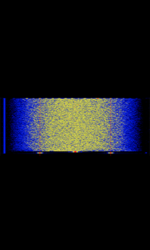8PSK
8PSK8-Phase Phase-Shift Keying (3 bits per symbol), developed by John Phelps (KL4YFD) in 2014, is a digital mode in Fldigi designed for medium-speed data transmission via standard FMFrequency Modulation and SSBSingle-sideband modulation radios. It offers six modes optimized for weak signals on various bands (VHFVery High Frequency (30-300 MHz)/UHFUltra High Frequency (300-3000 MHz) and others) and employs heavy forward error correction (FECForward Error Correction) using different Viterbi polynomials. Unlike BPSKBinary Phase-Shift Keying (1 bit per symbol) or QPSKQuadrature Phase-Shift Keying (2 bits per symbol), 8PSK8-Phase Phase-Shift Keying (3 bits per symbol) uses eight phase states and requires RSID-enabled modes (Reed-Solomon Identification, instead of standard AFC) to accurately determine the mode and center frequency. An optional pilot carrier—ideally set at -40 dBThe decibel (dB) is a logarithmic unit used to express the ratio of two values of a physical quantity, here the strength of a received signal. or higher—provides a crucial frequency/phase reference.
A pilot carrier in 8PSK8-Phase Phase-Shift Keying (3 bits per symbol) extends its use especially over HFHigh Frequency (3-30 MHz) SSBSingle-sideband modulation, even with older radios prone to frequency drift. It improves decoding by compensating for drift (with a precision of ±½ HzHertz (Hz), unit of frequency, defined as one cycle per second (1 Hz).), offering a stable reference and real-time RFRadio Frequency channel quality information. The pilot tone is detected using a sliding FFT (SFFT) with roughly 1 HzHertz (Hz), unit of frequency, defined as one cycle per second (1 Hz). resolution. For initial signal acquisition, RSID or manual tuning is necessary. The system locks the pilot tone when its signal-to-noise (s/n) ratio is 2:1 or better, adjusting the tracking point in discrete 1 HzHertz (Hz), unit of frequency, defined as one cycle per second (1 Hz). steps once per second. The tone is transmitted during both the 8PSK8-Phase Phase-Shift Keying (3 bits per symbol) preamble and data transmission.
For 8FSK, transmitter linearity is critical since overdrive (often due to excessive audio levels) can cause bandwidth expansion, poor reception, and tuning challenges. Generally, these sensitive modes require minimal power, with PSKPhase-Shift Keying modes sometimes outperforming CWContinuous Wave in decoding.
There are many ways to construct a PSKPhase-Shift Keying constellation, but 8-PSK8-Phase Phase-Shift Keying (3 bits per symbol) is the most common. There are more than eight phases, so the error rate is too high. There are better, though more complex, modulation options, such as quadrature amplitude modulation (QAMQuadrature Amplitude Modulation).
Effective PSKPhase-Shift Keying reception needs a phase-locked demodulator. Fldigi features a fast-acquire, slow-tracking AFC system: align the red bandwidth bar over the signal, click, and the system will quickly lock and commence decoding. Although it’s hard to visually distinguish BPSKBinary Phase-Shift Keying (1 bit per symbol) from QPSKQuadrature Phase-Shift Keying (2 bits per symbol) (except under high signal-to-noise conditions), switching modes and reacquiring the signal can aid in proper decoding.
